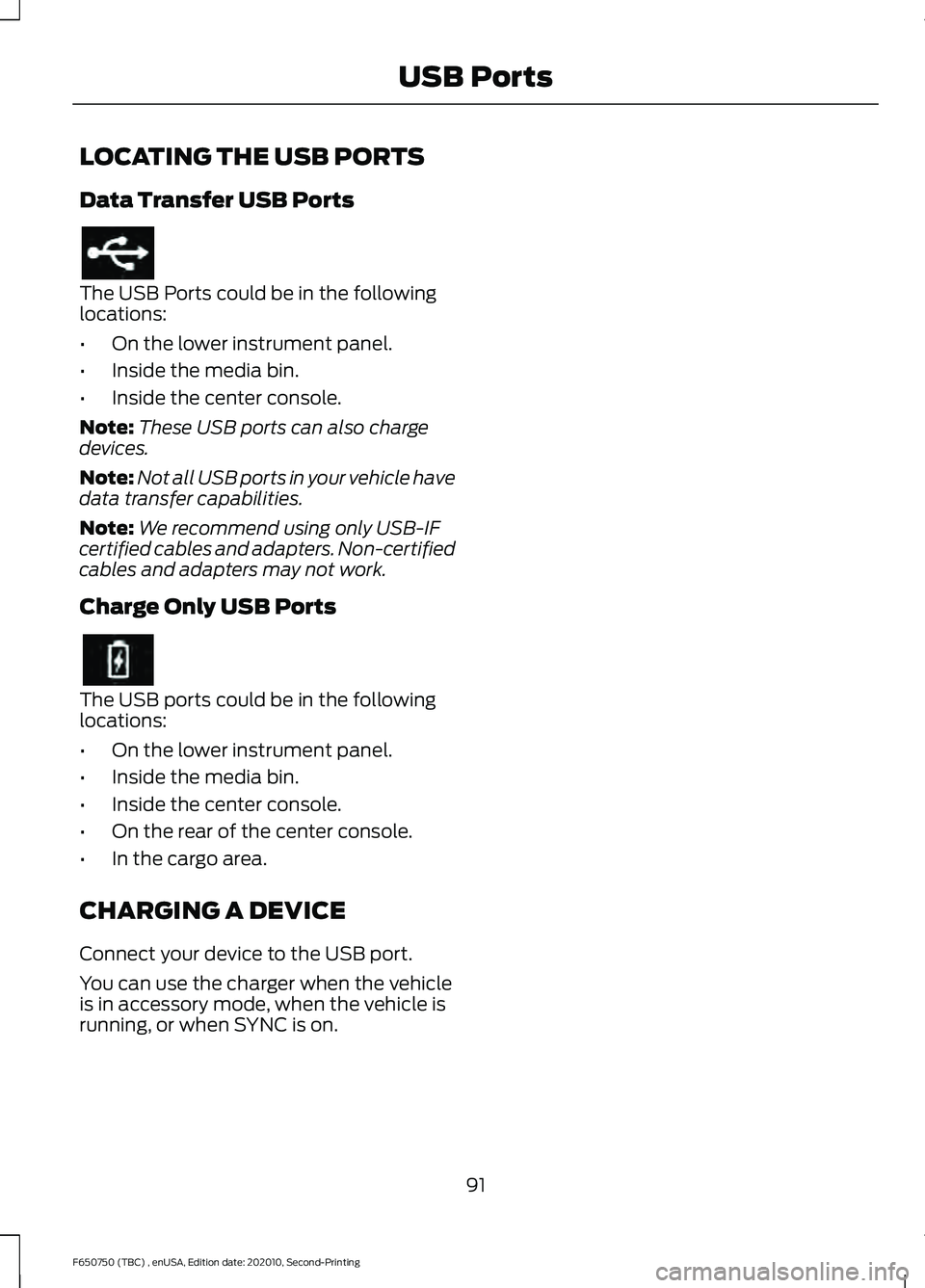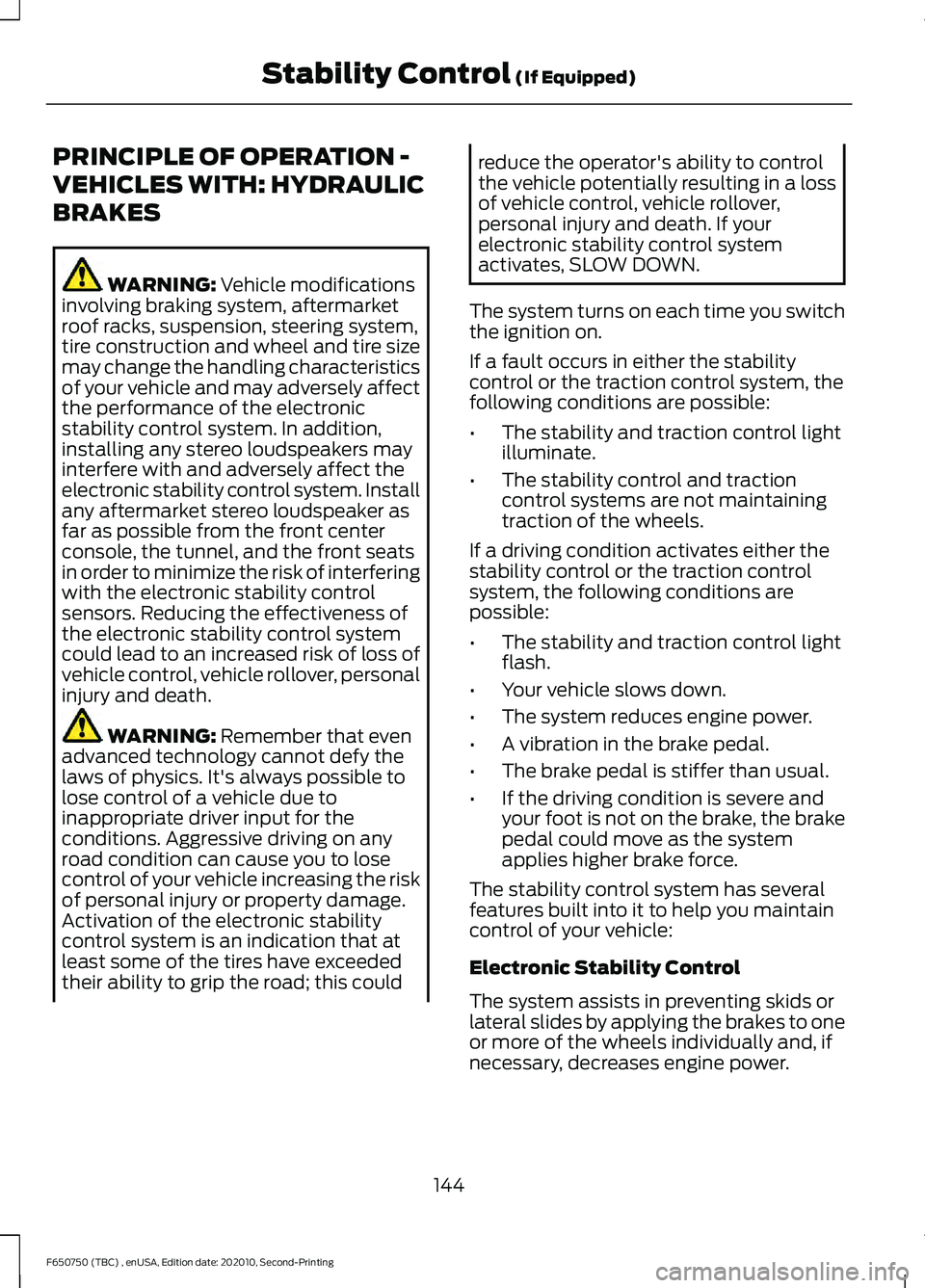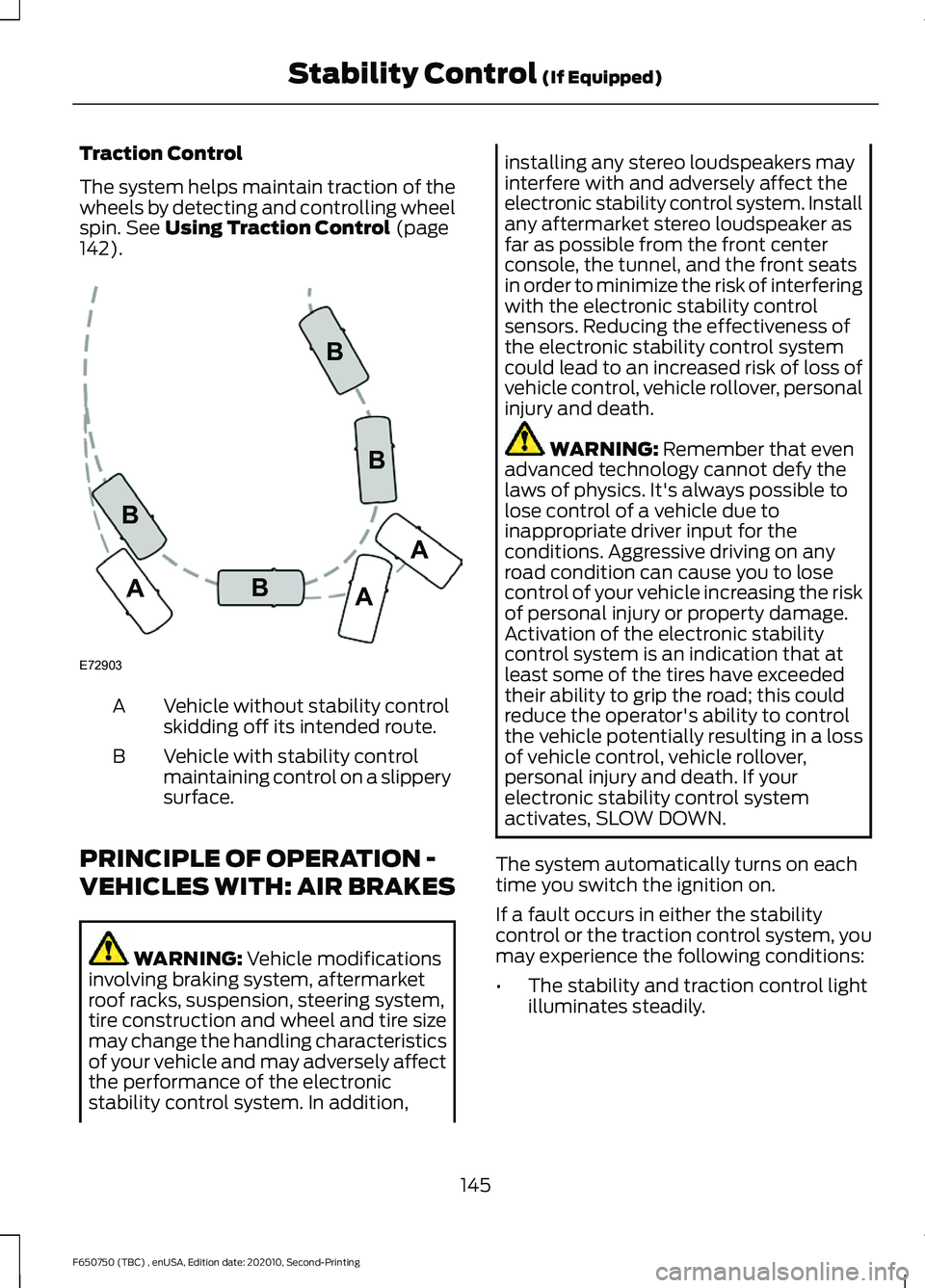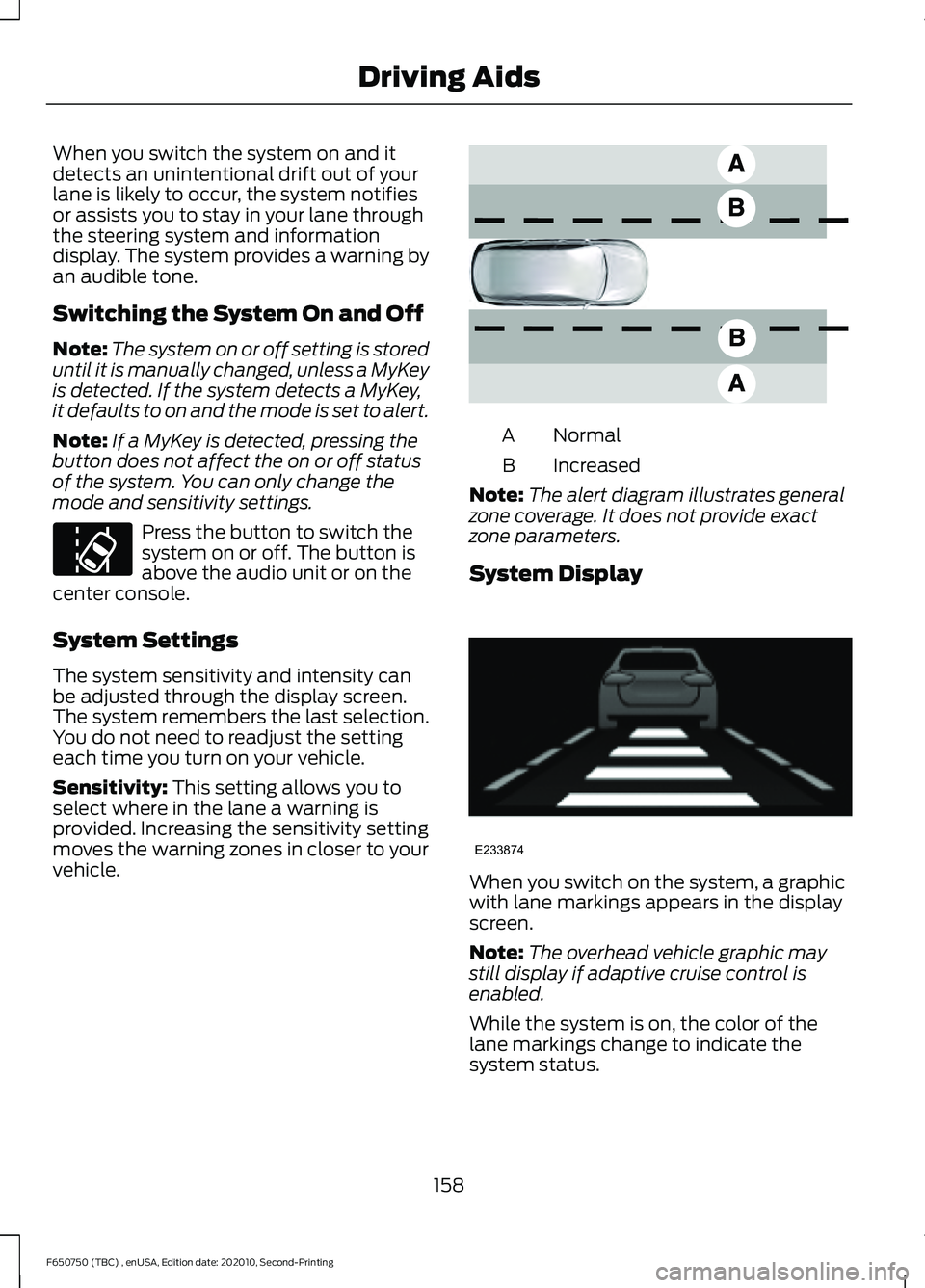2021 FORD F650/750 center console
[x] Cancel search: center consolePage 94 of 390

LOCATING THE USB PORTS
Data Transfer USB Ports
The USB Ports could be in the following
locations:
•
On the lower instrument panel.
• Inside the media bin.
• Inside the center console.
Note: These USB ports can also charge
devices.
Note: Not all USB ports in your vehicle have
data transfer capabilities.
Note: We recommend using only USB-IF
certified cables and adapters. Non-certified
cables and adapters may not work.
Charge Only USB Ports The USB ports could be in the following
locations:
•
On the lower instrument panel.
• Inside the media bin.
• Inside the center console.
• On the rear of the center console.
• In the cargo area.
CHARGING A DEVICE
Connect your device to the USB port.
You can use the charger when the vehicle
is in accessory mode, when the vehicle is
running, or when SYNC is on.
91
F650750 (TBC) , enUSA, Edition date: 202010, Second-Printing USB Ports
Page 147 of 390

PRINCIPLE OF OPERATION -
VEHICLES WITH: HYDRAULIC
BRAKES
WARNING: Vehicle modifications
involving braking system, aftermarket
roof racks, suspension, steering system,
tire construction and wheel and tire size
may change the handling characteristics
of your vehicle and may adversely affect
the performance of the electronic
stability control system. In addition,
installing any stereo loudspeakers may
interfere with and adversely affect the
electronic stability control system. Install
any aftermarket stereo loudspeaker as
far as possible from the front center
console, the tunnel, and the front seats
in order to minimize the risk of interfering
with the electronic stability control
sensors. Reducing the effectiveness of
the electronic stability control system
could lead to an increased risk of loss of
vehicle control, vehicle rollover, personal
injury and death. WARNING:
Remember that even
advanced technology cannot defy the
laws of physics. It's always possible to
lose control of a vehicle due to
inappropriate driver input for the
conditions. Aggressive driving on any
road condition can cause you to lose
control of your vehicle increasing the risk
of personal injury or property damage.
Activation of the electronic stability
control system is an indication that at
least some of the tires have exceeded
their ability to grip the road; this could reduce the operator's ability to control
the vehicle potentially resulting in a loss
of vehicle control, vehicle rollover,
personal injury and death. If your
electronic stability control system
activates, SLOW DOWN.
The system turns on each time you switch
the ignition on.
If a fault occurs in either the stability
control or the traction control system, the
following conditions are possible:
• The stability and traction control light
illuminate.
• The stability control and traction
control systems are not maintaining
traction of the wheels.
If a driving condition activates either the
stability control or the traction control
system, the following conditions are
possible:
• The stability and traction control light
flash.
• Your vehicle slows down.
• The system reduces engine power.
• A vibration in the brake pedal.
• The brake pedal is stiffer than usual.
• If the driving condition is severe and
your foot is not on the brake, the brake
pedal could move as the system
applies higher brake force.
The stability control system has several
features built into it to help you maintain
control of your vehicle:
Electronic Stability Control
The system assists in preventing skids or
lateral slides by applying the brakes to one
or more of the wheels individually and, if
necessary, decreases engine power.
144
F650750 (TBC) , enUSA, Edition date: 202010, Second-Printing Stability Control
(If Equipped)
Page 148 of 390

Traction Control
The system helps maintain traction of the
wheels by detecting and controlling wheel
spin. See Using Traction Control (page
142). Vehicle without stability control
skidding off its intended route.
A
Vehicle with stability control
maintaining control on a slippery
surface.
B
PRINCIPLE OF OPERATION -
VEHICLES WITH: AIR BRAKES WARNING:
Vehicle modifications
involving braking system, aftermarket
roof racks, suspension, steering system,
tire construction and wheel and tire size
may change the handling characteristics
of your vehicle and may adversely affect
the performance of the electronic
stability control system. In addition, installing any stereo loudspeakers may
interfere with and adversely affect the
electronic stability control system. Install
any aftermarket stereo loudspeaker as
far as possible from the front center
console, the tunnel, and the front seats
in order to minimize the risk of interfering
with the electronic stability control
sensors. Reducing the effectiveness of
the electronic stability control system
could lead to an increased risk of loss of
vehicle control, vehicle rollover, personal
injury and death.
WARNING:
Remember that even
advanced technology cannot defy the
laws of physics. It's always possible to
lose control of a vehicle due to
inappropriate driver input for the
conditions. Aggressive driving on any
road condition can cause you to lose
control of your vehicle increasing the risk
of personal injury or property damage.
Activation of the electronic stability
control system is an indication that at
least some of the tires have exceeded
their ability to grip the road; this could
reduce the operator's ability to control
the vehicle potentially resulting in a loss
of vehicle control, vehicle rollover,
personal injury and death. If your
electronic stability control system
activates, SLOW DOWN.
The system automatically turns on each
time you switch the ignition on.
If a fault occurs in either the stability
control or the traction control system, you
may experience the following conditions:
• The stability and traction control light
illuminates steadily.
145
F650750 (TBC) , enUSA, Edition date: 202010, Second-Printing Stability Control
(If Equipped)E72903A
AA
B
BB
B
Page 161 of 390

When you switch the system on and it
detects an unintentional drift out of your
lane is likely to occur, the system notifies
or assists you to stay in your lane through
the steering system and information
display. The system provides a warning by
an audible tone.
Switching the System On and Off
Note:
The system on or off setting is stored
until it is manually changed, unless a MyKey
is detected. If the system detects a MyKey,
it defaults to on and the mode is set to alert.
Note: If a MyKey is detected, pressing the
button does not affect the on or off status
of the system. You can only change the
mode and sensitivity settings. Press the button to switch the
system on or off. The button is
above the audio unit or on the
center console.
System Settings
The system sensitivity and intensity can
be adjusted through the display screen.
The system remembers the last selection.
You do not need to readjust the setting
each time you turn on your vehicle.
Sensitivity: This setting allows you to
select where in the lane a warning is
provided. Increasing the sensitivity setting
moves the warning zones in closer to your
vehicle. Normal
A
Increased
B
Note: The alert diagram illustrates general
zone coverage. It does not provide exact
zone parameters.
System Display When you switch on the system, a graphic
with lane markings appears in the display
screen.
Note:
The overhead vehicle graphic may
still display if adaptive cruise control is
enabled.
While the system is on, the color of the
lane markings change to indicate the
system status.
158
F650750 (TBC) , enUSA, Edition date: 202010, Second-Printing Driving AidsE173233 E165517 E233874
Page 386 of 390

Lug Nuts
See: Changing a Road Wheel........................ 277
M
Maintenance...................................................212 General Information........................................... 212
Manual Climate Control..............................79 Directing the Air..................................................... 79
Setting the Blower Motor Speed.................... 79
Setting the Temperature................................... 79
Switching Defrost On and Off......................... 79
Switching Maximum Air Conditioning On and Off................................................................ 80
Switching Recirculated Air On and Off........................................................................\
80
Switching the Air Conditioning On and Off........................................................................\
. 79
Switching the Climate Control On and Off........................................................................\
. 79
Manual Seats..................................................84 Manual Lumbar ................................................... 85
Moving the Seat Backward and Forward.............................................................. 84
Recline Adjustment............................................ 84
Tilting the Seatback Forward (Two-Passenger Bench Seat)................... 85
Message Center See: Information Displays................................. 70
Mirrors See: Windows and Mirrors................................ 59
Mobile Communications Equipment......19
Motorcraft Parts - 6.7L Diesel.................283
Motorcraft Parts - 7.3L...............................285
N
Noise Pollution Control.................................21 Air Intake System................................................... 21
Body........................................................................\
.... 21
Cooling System...................................................... 21
Engine........................................................................\
21
Exhaust System..................................................... 21
Transmission Enclosure...................................... 21
Normal Scheduled Maintenance...........323 Intelligent Oil-Life Monitor™ - Diesel Engine
Only.................................................................... 323
Normal Maintenance Intervals..................... 324O
Oil Change Indicator Reset......................220
Base Cluster......................................................... 220
High Series Cluster............................................ 220
Oil Check See: Engine Oil Check - 6.7L Diesel.............218
See: Engine Oil Check - 7.3L............................ 217
Opening and Closing the Hood...............213 Closing the Hood................................................ 214
Opening the Hood.............................................. 214
Ordering Additional Owner's Literature.......................................................191
Obtaining a French Owner ’s Manual...........191
Overhead Console
.........................................92
P
Parking Brake
..................................................131
Air Brakes............................................................... 132
Hydraulic Brakes.................................................. 131
Passive Anti-Theft System..........................51 SecuriLock®............................................................ 51
PATS See: Passive Anti-Theft System...................... 51
Perchlorate.........................................................17
Playing Media From a USB Device
.........313
Selecting the USB Device................................ 313
Supported Audio File Formats....................... 313
Power Door Locks See: Locking and Unlocking............................. 49
Power Seats
.....................................................85
Air-Ride Seat......................................................... 85
Power Steering Fluid Check.....................238
Power Take-Off
.............................................126
Power Windows..............................................59
Bounce-Back......................................................... 59
One-Touch Up or Down..................................... 59
Window Lock......................................................... 59
Pre-Collision Assist - Vehicles With: Air Brakes.............................................................161
Blocked Sensors................................................. 162
Pre-Collision Assist Settings.......................... 162
Using the Pre-Collision Assist System........161
Pre-Collision Assist - Vehicles With: Hydraulic Brakes
........................................163
Adjusting the Pre-Collision Assist
Settings............................................................. 165
383
F650750 (TBC) , enUSA, Edition date: 202010, Second-Printing Index